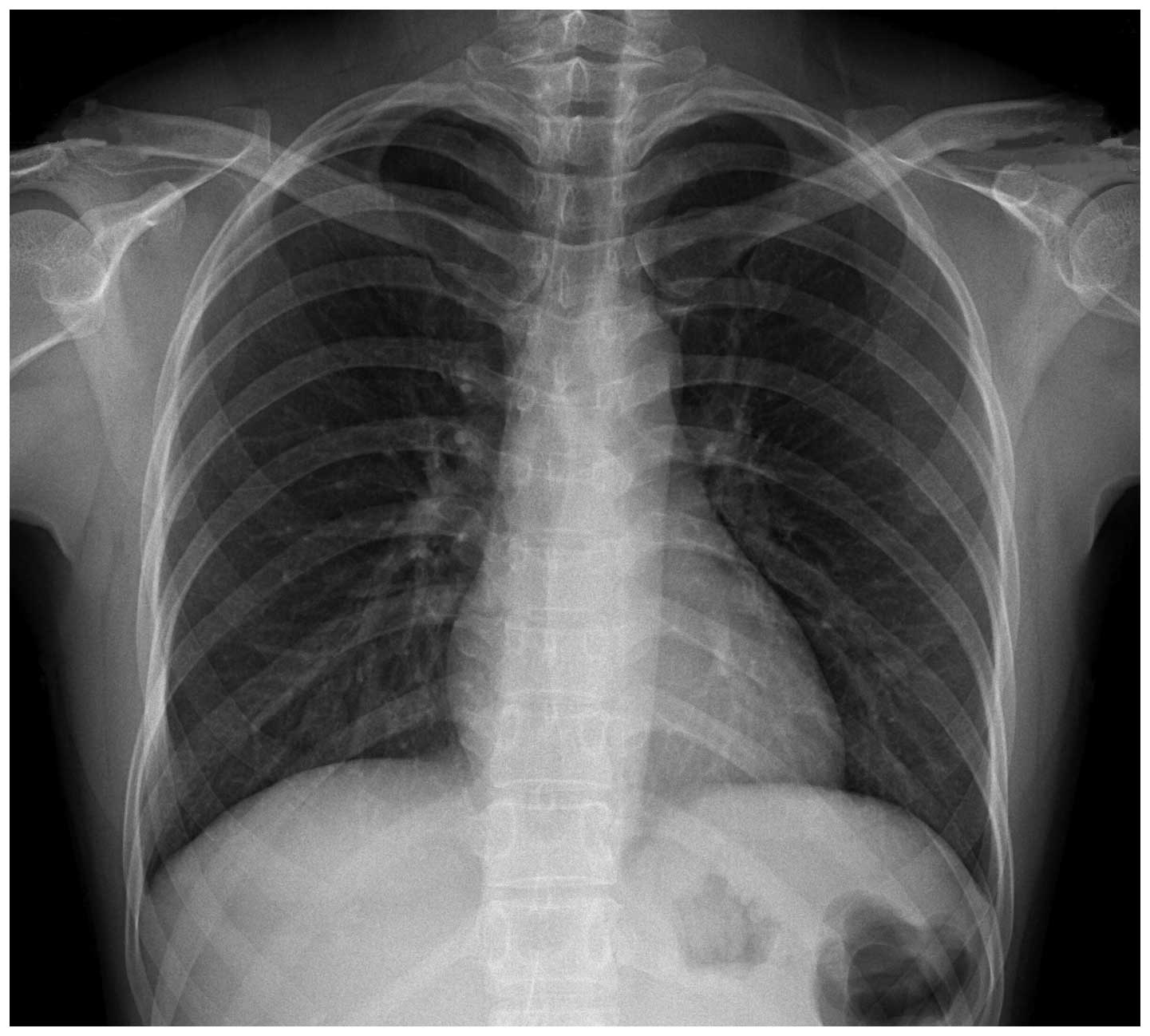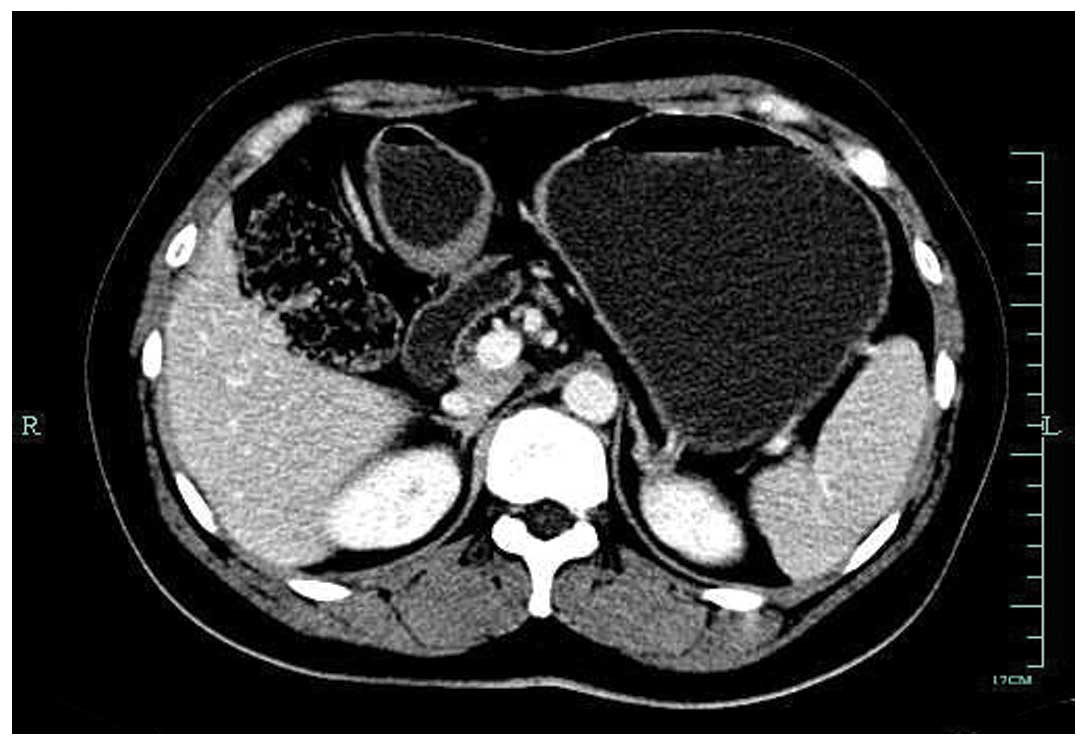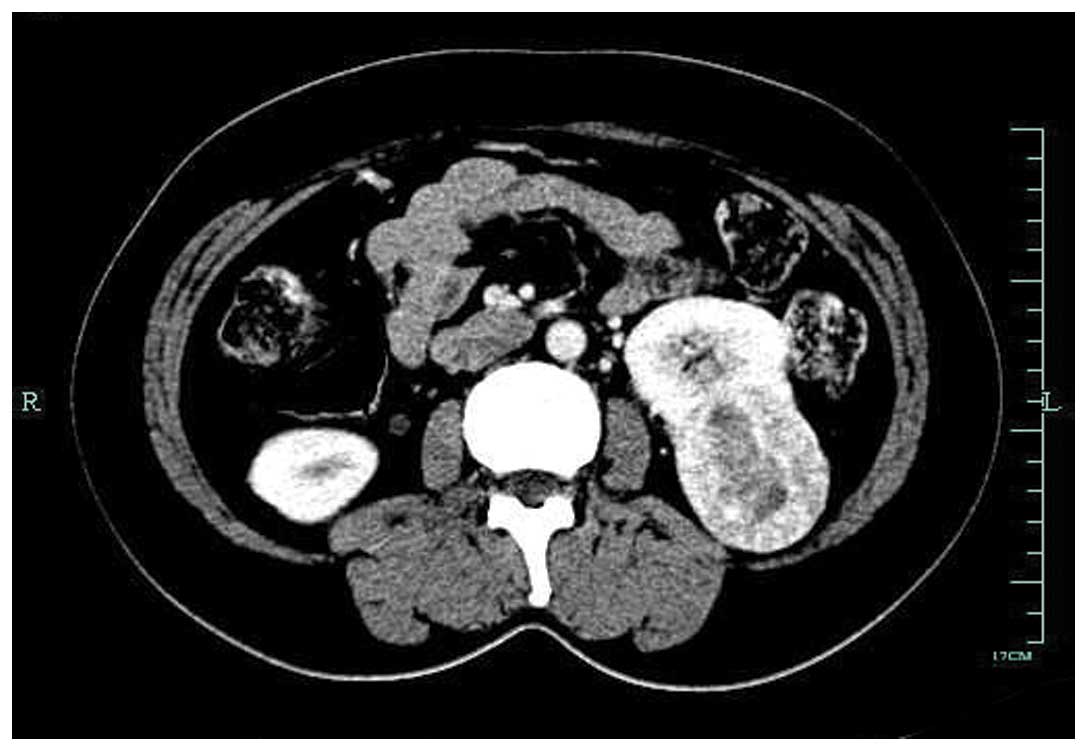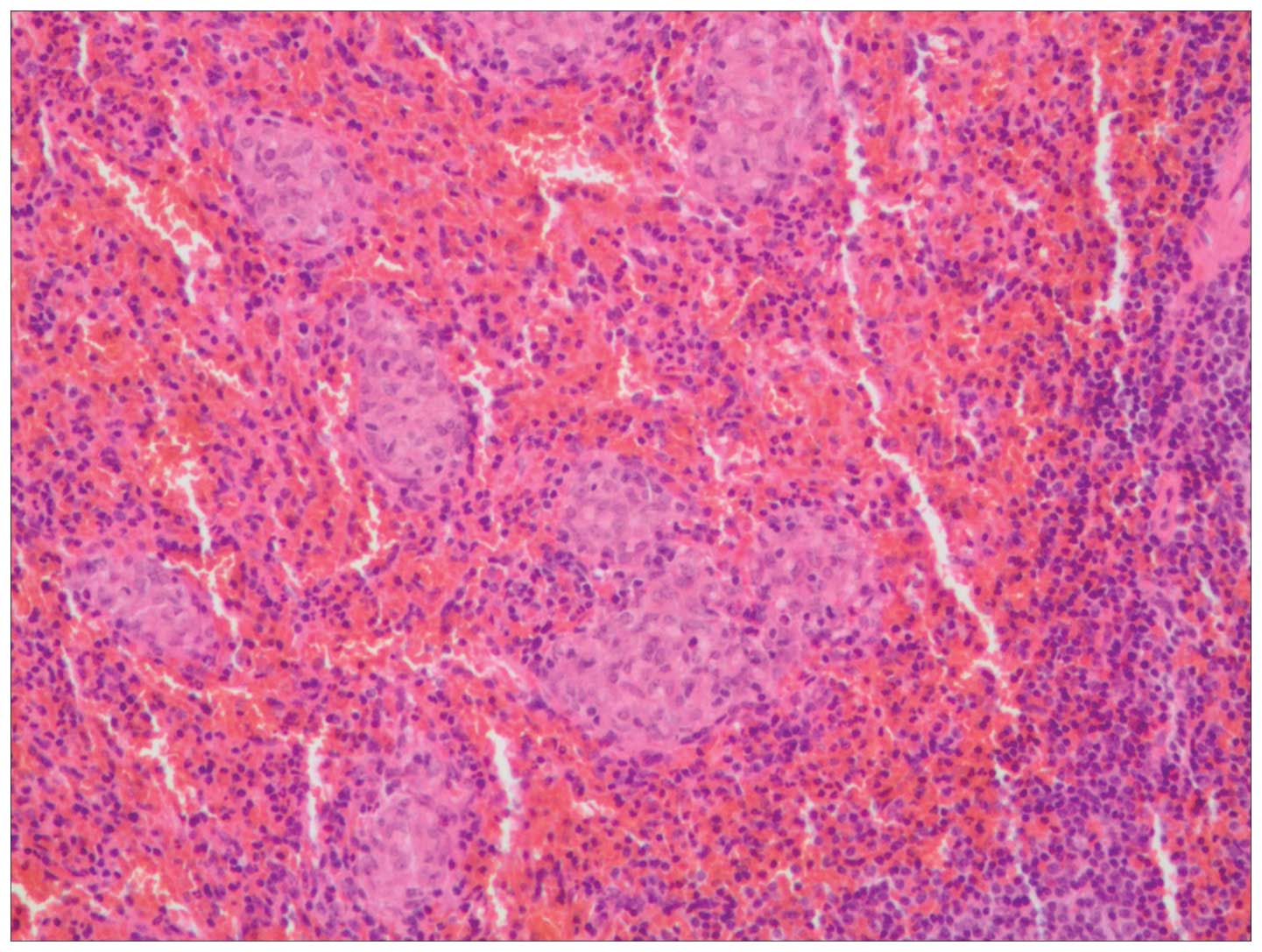|
1
|
Warshauer DM and Lee JK: Imaging
manifestations of abdominal sarcoidosis. AJR Am J Roentgenol.
182:15–28. 2004. View Article : Google Scholar : PubMed/NCBI
|
|
2
|
Jundson MA: Hepatic, splenic and
gastrointestinal involvement with sarcoidosis. Semin Respir Crit
Care Med. 23:529–541. 2002. View Article : Google Scholar : PubMed/NCBI
|
|
3
|
Kataoka M, Nakata Y, Hiramatsu J, Okazaki
K, Fujimori Y, Ueno Y, Tanimoto Y, Kanehiro A, Tada S and Harada M:
Hepatic and splenic sarcoidosis evaluated by multiple imaging
modalities. Intern Med. 37:449–453. 1998. View Article : Google Scholar : PubMed/NCBI
|
|
4
|
Vagal AS, Shipley R and Meyer CA:
Radiological manifestations of sarcoidosis. Clin Dermatol.
25:312–325. 2007. View Article : Google Scholar : PubMed/NCBI
|
|
5
|
Pérez-Grueso MJ, Repiso A, Gómez R,
Gonzalez C, de Artaza T, Valle J, García A and Carrobles JM:
Splenic focal lesions as manifestation of sarcoidosis:
Characterization with contrast-enhanced sonography. J Clin
Ultrasound. 35:405–408. 2007. View Article : Google Scholar : PubMed/NCBI
|
|
6
|
Warshauer DM: Splenic sarcoidosis. Semin
Ultrasound CT MR. 28:21–27. 2007. View Article : Google Scholar : PubMed/NCBI
|
|
7
|
Unver Dogan N, Uysal II, Demirci S, Dogan
KH and Kolcu G: Accessory spleens at autopsy. Clin Anat.
24:757–762. 2011. View
Article : Google Scholar : PubMed/NCBI
|
|
8
|
Thompson JC: The stomach and duodenum.
Textbook of Surgery: The Biological Basis of Modern Surgical
Practice. Sabiston DC: (Philadephia, PA). WB Saunders Company.
810–853. 1986.
|
|
9
|
Soutto MM, Tempes BC, Lambert BF, Trindade
EN and Trindade MR: Laparoscopic splenectomy for isolated splenic
sarcoidosis. JSLS. 18:155–159. 2014. View Article : Google Scholar : PubMed/NCBI
|
|
10
|
Bauones S, Le Corroller T, Durieux O,
Guenoun D, Del Grande J, Pirro N and Champsaur P: Splenic
sarcoidosis mimicking neoplastic disease. J Clin Ultrasound.
42:38–41. 2014. View Article : Google Scholar : PubMed/NCBI
|
|
11
|
Joglekar SP, Hudson RL, Lgasundaram R and
Pereira JH: ‘Surgical cure’ for non parathyroid hypercalcemia.
World J Surg Oncol. 7:232009. View Article : Google Scholar : PubMed/NCBI
|
|
12
|
Zia H, Zemon H and Brody F: Laparoscopic
splenectomy for isolated sarcoidosis of the spleen. J Laparoendosc
Adv Surg Tech A. 15:160–162. 2005. View Article : Google Scholar : PubMed/NCBI
|
|
13
|
Palade R, Voiculescu1 D, Suliman E and
Simion G: Splenic sarcoidosis - a case report. Chirurgia (Bucur).
107:670–674. 2012.PubMed/NCBI
|
|
14
|
Salazar A, Mañá J, Corbella X, Albareda JM
and Pujol R: Splenomegaly in sarcoidosis: A report of 16 cases.
Sarcoidosis. 12:131–134. 1995.PubMed/NCBI
|
|
15
|
Madaule S, Lauque D, Sailler L, Arlet P
and Carles P: Splenomegaly in sarcoidosis: Clinical features and
outcome. Analysis of 17 cases. Rev Med Interne. 25:348–356.
2004.(In French). View Article : Google Scholar : PubMed/NCBI
|
|
16
|
Giovinale M, Fonnesu C, Soriano A,
Cerquaglia C, Curigliano V, Verrecchia E, De Socio G, Gasbarrini G
and Manna R: Atypical sarcoidosis: Case reports and review of the
literature. Eur Rev Med Pharmacol Sci. 13(Suppl 1): S37–S44.
2009.
|
|
17
|
Chen MY, Cai JT, Du Q and Wang LJ:
Sarcoidosis of spleen presenting with solitary thrombopenia. Eur J
of Intern Med. 20:e122009. View Article : Google Scholar
|
|
18
|
Ogiwara Y, Mori S, Iwama M, Sawabe M,
Takemoto M, Kanazawa N, Furuta K, Fukuda I, Kondo Y, Kimbara Y, et
al: Hypoglycemia due to ectopic secretion of insulin-like growth
factor-I in a patient with an isolated sarcoidosis of the spleen.
Endocr J. 57:325–330. 2010. View Article : Google Scholar : PubMed/NCBI
|
|
19
|
Cuilliere-Dartigues P, Meyohas MC,
Balladur P, Gorin NC and Coppo P: Splenic sarcoidosis: An unusual
aetiology of agranulocytosis. Am J Hematol. 85:8912010. View Article : Google Scholar : PubMed/NCBI
|
|
20
|
Dennis BA, Jajosky RP and Harper RJ:
Splenic sarcoidosis without focal nodularity: A case of
1,25-dihydroxyvitamin D-mediated hypercalcemia localized with FDG
PET/CT. Endocr Pract. 20:e29–e33. 2014. View Article : Google Scholar
|
|
21
|
Xiao GQ, Zinberg JM and Unger PD:
Asymptomatic sarcoidosis presenting as massive splenomegaly. Am J
Med. 113:698–699. 2002. View Article : Google Scholar : PubMed/NCBI
|
|
22
|
Fordice J, Katras T, Jackson RE, Cagle PT,
Jackson D, Zaleski H and Asimacopoulos PJ: Massive splenomegaly in
sarcoidosis. South Med J. 85:775–778. 1992. View Article : Google Scholar : PubMed/NCBI
|
|
23
|
Patel I, Ismaji M and Steuer A:
Sarcoidosis presenting as massive splenic infarction. Case Rep
Rheumatol. 2012:8347582012.PubMed/NCBI
|
|
24
|
Bergoin C, Lamblin C and Wallaert B:
Biological manifestations of sarcoidosis. Ann Med Interne (Paris).
152:34–38. 2001.(In French). PubMed/NCBI
|
|
25
|
Baudin B: Angiotensin I-converting enzyme
(ACE) for sarcoidosis diagnosis. Pathol Biol (Paris). 53:183–188.
2005.(In French). View Article : Google Scholar : PubMed/NCBI
|
|
26
|
Folz SJ, Johnson CD and Swensen SJ:
Abdominal manifestations of sarcoidosis in CT studies. J Comput
Assist Tomogr. 19:573–579. 1995. View Article : Google Scholar : PubMed/NCBI
|
|
27
|
Fiorention F, Bribani A and Rosselli A: A
rare cause of the left upper quadrant abdominal pain. Intern Emerg
Med. 6:55–57. 2011. View Article : Google Scholar : PubMed/NCBI
|
|
28
|
Kessler A, Mitchell DG, Israel HL and
Goldberg BB: Hepatic and splenic sarcoidosis: Ultrasound and MR
imaging. Abdom Imaging. 18:159–163. 1993. View Article : Google Scholar : PubMed/NCBI
|
|
29
|
Grzelak P, Augsburg L, Majos A, Stefanczyk
L, Gorski P, Piotrowski W and Antczak A: Use of contrast-enhanced
ultrasonography in hepatosplenic sarcoidosis: Report of 2 cases.
Pol J Radiol. 77:60–63. 2012. View Article : Google Scholar : PubMed/NCBI
|
|
30
|
Stang A, Keles H, Hentschke S, von
Seydewitz CU, Dahlke J, Malzfeldt E and Braumann D: Differentiation
of benign from malignant focal splenic lesions using sulfur
hexafluoride-fillled microbubble contrast-enhanced pulse-inversion
sonography. AJR Am J Roentgenol. 193:709–721. 2009. View Article : Google Scholar : PubMed/NCBI
|
|
31
|
Tana C, Iannetti G, Mezzetti A and
Schiavone C: Splenic sarcoidosis remains a diagnostic challenge. J
Clin Ultrasound. 42:1562014. View Article : Google Scholar : PubMed/NCBI
|
|
32
|
Franquet T, Oteo JA, Cozcoluella R and
Casas JM: Multinodular splenic sarcoidosis: Discordant CT and
sonographic findings. AJR Am J Roentgenol. 156:1113–1114. 1991.
View Article : Google Scholar : PubMed/NCBI
|
|
33
|
Raber EL, Haba J and Beck P: Splenic
sarcoidosis: A case report and review of the imaging findings of
multiple incidental splenic lesios as the initial presentation of
sarcoidosis. Can J Gastroenterol. 25:477–478. 2011. View Article : Google Scholar : PubMed/NCBI
|
|
34
|
Kataoka M, Nakata Y, Hiramatsu J, Okazaki
K, Fujimori Y, Ueno Y, Tanimoto Y, Kanehiro A, Tada S and Harada M:
Hepatic and splenic sarcoidosis evaluated by multiple imaging
modalities. Internal Med. 37:449–453. 1998. View Article : Google Scholar
|
|
35
|
Sharma OP, Vucinic V and James DG:
Splenectomy in sarcoidosis: Indications, complications and
long-term followup. Sarcoidosis Vasc Diffuse Lung Dis. 19:66–70.
2002.PubMed/NCBI
|


















